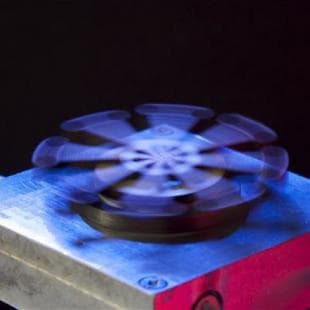Energy From CO2 Could Power Future Space Missions And Life On Mars
Ever since mankind has started exploring the Red Planet, it has found the need for a sustainable power source. Harvesting energy in outer space has always been a challenge being tackled by scientists across the globe. Well, a team of researchers from Northumbria University and Edinburgh University has developed a new technique based on the Leidenfrost effect, that can produce energy from carbon dioxide (CO2). The Leidenfrost effect is based on a phenomenon that occurs when a liquid comes into contact with a surface much higher in temperature than its boiling point. This effect is commonly applies to solid carbon dioxide or what we call 'dry ice'. The vapours created as a result of blocks of dry ice levitating above hot surfaces protected by a barrier, can be used to power an engine. It's an innovative idea as the Leidenfrost effect has been used for the first time as a way of harvesting energy. And it's ingenuity lies in the fact that the technique can be used in extreme environments such as the outer space.
As exciting as the novel technique are its implications. Using the research work's results proposed by Northumbria and Edinburgh Universities, using the naturally available solid carbon dioxide as a resource for sustainable future space missions to Mars are possible. This deduction comes from the fact that NASA’s Mars Reconnaissance Orbiter (MRO) suggests that, unlike Earth, dry ice may be naturally and abundantly available on Mars. In fact, one of the researchers, Dr. Rodrigo Ledesma-Aguilar shares that Carbon Di-oxide is a widely available resource which undergoes cyclic phase changes under the natural Martian temperature variations.

Leidenfrost Effect - image by Jonathan Sanderson
Acknowledging the need to tackle the huge challenge of finding new ways to harvest energy, led this research team to develop the proposed Leidenfrost Engine, where the high-pressure vapour layer creates freely rotating rotors whose energy is converted into power without the need of a bearing. This therefore hints at the frictionless transport of the future and a wide range of other space missions, yet unimaginable.
The team is certain that if the human race is able to adapt and transform its knowledge to make it aligned with the constraints of the strange world of the outer space, such that the naturally available resources in there that aren't readily available on Earth are exploited to their optimum potential, that's how we can build our future on other planets. Does that take a dip into the concept of building human colonies on other planets when the dooms day finally arrives? We can only imagine the implications of the wide range of applications of this novel technique.
What are your thoughts on harvesting energy from carbon dioxide and providing power for spacecrafts right on the planet Mars? Share your opinions with us in comments below.
Source: <a href="https://www.northumbria.ac.uk/about-us/news-events/news/2015/03/breakthrough-in-energy-harvesting-could-power-life-on-mars/" target="_blank" rel="noopener noreferrer">Breakthrough in energy harvesting could power ‘life on Mars’</a>
As exciting as the novel technique are its implications. Using the research work's results proposed by Northumbria and Edinburgh Universities, using the naturally available solid carbon dioxide as a resource for sustainable future space missions to Mars are possible. This deduction comes from the fact that NASA’s Mars Reconnaissance Orbiter (MRO) suggests that, unlike Earth, dry ice may be naturally and abundantly available on Mars. In fact, one of the researchers, Dr. Rodrigo Ledesma-Aguilar shares that Carbon Di-oxide is a widely available resource which undergoes cyclic phase changes under the natural Martian temperature variations.

Leidenfrost Effect - image by Jonathan Sanderson
Acknowledging the need to tackle the huge challenge of finding new ways to harvest energy, led this research team to develop the proposed Leidenfrost Engine, where the high-pressure vapour layer creates freely rotating rotors whose energy is converted into power without the need of a bearing. This therefore hints at the frictionless transport of the future and a wide range of other space missions, yet unimaginable.
The team is certain that if the human race is able to adapt and transform its knowledge to make it aligned with the constraints of the strange world of the outer space, such that the naturally available resources in there that aren't readily available on Earth are exploited to their optimum potential, that's how we can build our future on other planets. Does that take a dip into the concept of building human colonies on other planets when the dooms day finally arrives? We can only imagine the implications of the wide range of applications of this novel technique.
What are your thoughts on harvesting energy from carbon dioxide and providing power for spacecrafts right on the planet Mars? Share your opinions with us in comments below.
Source: <a href="https://www.northumbria.ac.uk/about-us/news-events/news/2015/03/breakthrough-in-energy-harvesting-could-power-life-on-mars/" target="_blank" rel="noopener noreferrer">Breakthrough in energy harvesting could power ‘life on Mars’</a>
0
